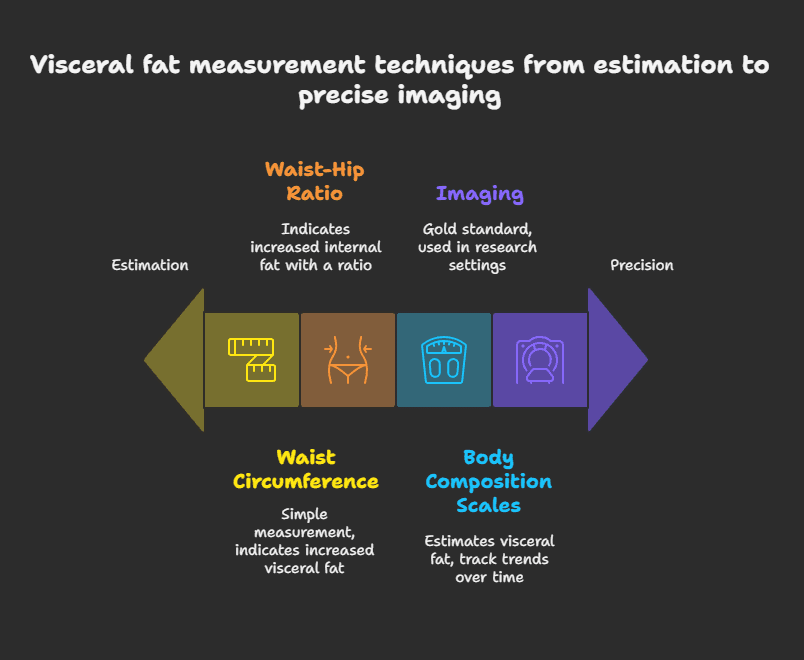Deep belly fat, or visceral fat, as it’s also called, is a toxic type of inner fat that resides around organs. Unlike the pinchable fat under your skin, it’s a serious hazard that belly fat poses. Knowing the hazards of visceral fat and the ways to burn visceral fat is a crucial measure to safeguard your long-term health. In this article, we will be looking at what visceral fat is, how it is different from subcutaneous fat, why it is so dangerous, and real-world tips on how to attack this sneaky threat.
If you’ve ever wondered why two people with the same body mass index (BMI) can have very different health profiles, visceral fat holds part of the answer. Even at a healthy weight, someone carrying more deep belly fat may face a higher risk of chronic diseases than someone with a higher BMI but less internal fat. Let’s dive in.
What Is Visceral Fat?
Visceral fat is an active type of fat stored deep in the abdominal cavity. It encircles large organs, like the liver, pancreas, and intestines, serving as a cushion but also producing hormones and inflammatory chemicals. Unlike subcutaneous fat, which is located just beneath the skin, visceral fat can only be accurately measured through imaging methods like CT scans or MRI.
This “hidden” internal fat is influenced by genetic factors, diet, physical activity, sleep quality, and stress levels. While some visceral fat is normal and even protective in small amounts, excess visceral fat upsets your body’s hormonal balance, raises inflammation, and increases your risk for serious conditions.
Visceral Fat vs. Subcutaneous Fat: Key Differences
Although both types of fat accumulate in the abdomen, subcutaneous and visceral fat behave very differently:
Location
- Subcutaneous fat lies directly under the skin and can be pinched between your fingers.
- Visceral fat is deeper, enveloping organs and not accessible on the surface.
Metabolic Activity
- Subcutaneous fat is fairly inactive, holding calories in reserve to be used at a later time.
- Isceral fat is very active, releasing free fatty acids and inflammatory cytokines into the bloodstream.
Health Implications
- Extra subcutaneous fat adds to body weight but is less likely to have direct metabolic consequences.
- Visceral fat creates havoc with insulin sensitivity, blood pressure, and lipid balance, fueling the progression of metabolic syndrome.
Knowing these distinctions explains why addressing visceral fat is critical, even when overall body weight appears fine.
The Hazards of Visceral Fat
Visceral fat gets its nickname “the silent killer” because it is concealed inside and stealthily compromises your well-being. Two important facts make it particularly dangerous:
Inflammatory Signals
Visceral fat cells release pro-inflammatory cytokines (e.g., interleukin-6, tumor necrosis factor-alpha) that initiate chronic, low-grade inflammation. This inflammatory condition injures blood vessels and blunts insulin signaling.
Hormonal Disruption
It also releases hormones such as adiponectin and leptin in changed proportions, resulting in insulin resistance, appetite dysregulation, and increased blood pressure.
In addition to these mechanisms, deep belly fat generates a feedback loop: inflammation increases fat storage, and excess fat increases inflammation. Over time, this vicious cycle speeds up disease progression.
Health Risks of Deep Belly Fat
Having too much deep belly fat significantly increases your risk for a variety of conditions
1. Cardiovascular Disease
Visceral fat encourages atherosclerosis by raising “bad” LDL cholesterol and lowering “good” HDL cholesterol. Individuals with excess internal fat are at least 50% more likely to have heart attacks or strokes than those with less.
2. Diabetes
By interfering with insulin sensitivity, visceral fat is a foundation of metabolic syndrome. Almost 80% of patients with type 2 diabetes have excessive deep belly fat.
3. Hypertension
The inflammatory substances secreted by visceral fat constrict blood vessels and harden arteries, increasing systolic and diastolic blood pressure in the long run.
4. Non-Alcoholic Fatty Liver Disease (NAFLD)
Visceral fat excess overloads the liver with free fatty acids, causing fat to build up in liver cells. If not controlled, this can advance to inflammation, fibrosis, and even cirrhosis.
5. Certain Cancers
Research has associated elevated visceral fat with enhanced risk of colorectal, post-menopausal breast, and pancreatic cancers, all possibly resulting from chronic inflammation and hormonal imbalance.
6. Cognitive Decline
New evidence is indicating that thick belly fat is responsible for inducing brain inflammation and increasing the risk of Alzheimer’s disease and other dementias.
All of these conditions not only affect quality of life but also contribute to healthcare expenses and shorten life expectancy. That’s why addressing visceral fat early is so important.
How to Reduce Visceral Fat
Reducing visceral fat demands a comprehensive approach. Here are evidence-based techniques to help you lose internal fat efficiently:
1. Adopt a Balanced, Nutrient-Dense Diet
- Focus on whole foods: vegetables, fruits, lean proteins, whole grains, and healthy fats (e.g., olive oil, nuts).
- Add soluble fiber: oats, beans, and flaxseed keep you full and level out blood sugar.
- Avoid added sugars and refined carbohydrates: sugary beverages, pastry, and white bread cause a rapid spike in insulin and encourage fat storage.
- Be moderate about drinking alcohol: Excess alcohol contributes to increased visceral fat storage.
2. Exercise Regularly
- Aerobic (Cardio): At least 150 minutes of moderate-intensity physical activity (e.g., brisk walking, cycling) per week. Cardio burns more calories and abdominal fat than other fats.
- Resistance Training: Weightlifting or body-weight exercises, two to three times a week, build muscle, enhancing resting metabolic rate and insulin sensitivity.
- High-Intensity Interval Training (HIIT): Intense bursts of activity with rest in between have been found to speed up visceral fat loss within 12 weeks.
3. Enhance Sleep and Stress Management
- Poor sleep (less than 7 hours a night) interferes with hunger hormones, causing overeating and weight gain.
- Chronic stress raises cortisol, a hormone that promotes fat storage around the belly. Add relaxation methods like meditation, deep breathing, or yoga.
4. Keep Portion Sizes Small and Practice Mindful Eating
- Mindful eating, tasting each bite, chewing slowly, and stopping between bites, prevents overeating.
- Employ smaller plates, have meals without screens, and attend to body hunger signals.
5. Seek Professional Assistance
- Partnership with a registered dietitian or certified fitness professional will offer customized recommendations and support.
- Physicians might, in certain situations, prescribe medications (e.g., orlistat) or refer to a bariatric professional for extreme obesity.
By combining these lifestyle modifications regularly, the majority of individuals can anticipate a 5–10% loss of visceral fat in 3 to 6 months, sufficient to witness significant improvements in blood sugar, blood pressure, and cholesterol.
Tracking Your Internal Fat: Equipment and Techniques

Measuring visceral fat accurately is more than what a bathroom scale can do. Here are usable techniques
Waist Circumference
Measure at navel level:
40 inches (102 cm) in men or > 35 inches (88 cm) in women is a sign of increased visceral fat.
Divide the waist measurement by the hip measurement:
Ratios of > 0.90 (men) or > 0.85 (women) indicate increased internal fat
Body Composition Scales
Bioelectrical impedance machines estimate visceral fat, but results differ by brand. Interpret trends over time, not absolute values.
Imaging
CT scans and MRIs are the gold standards for measuring visceral fat, often used in research or clinical settings.
Checking progress regularly, every 3 to 6 months, allows you to make changes to your diet and exercise program based on actual progress, not just on fluctuations in weight.
Conclusion
Deep belly fat, or visceral fat, might be hiding, but it need never go out of mind. As a form of internal fat, it drives inflammation, hormonal disruption, and a host of serious diseases, from heart disease and diabetes to certain cancers and cognitive decline. The good news is that targeted lifestyle changes, balanced nutrition, regular exercise, quality sleep, and stress management can substantially reduce visceral fat over time. By monitoring your waist circumference and staying consistent, you’ll not only slim your midsection but also safeguard your long-term health
Start today: swap refined carbs for whole grains, take a brisk walk after dinner, and commit to seven hours of sleep. With each small change, you’ll be chipping away at the hidden threat of visceral fat and building a healthier future.








